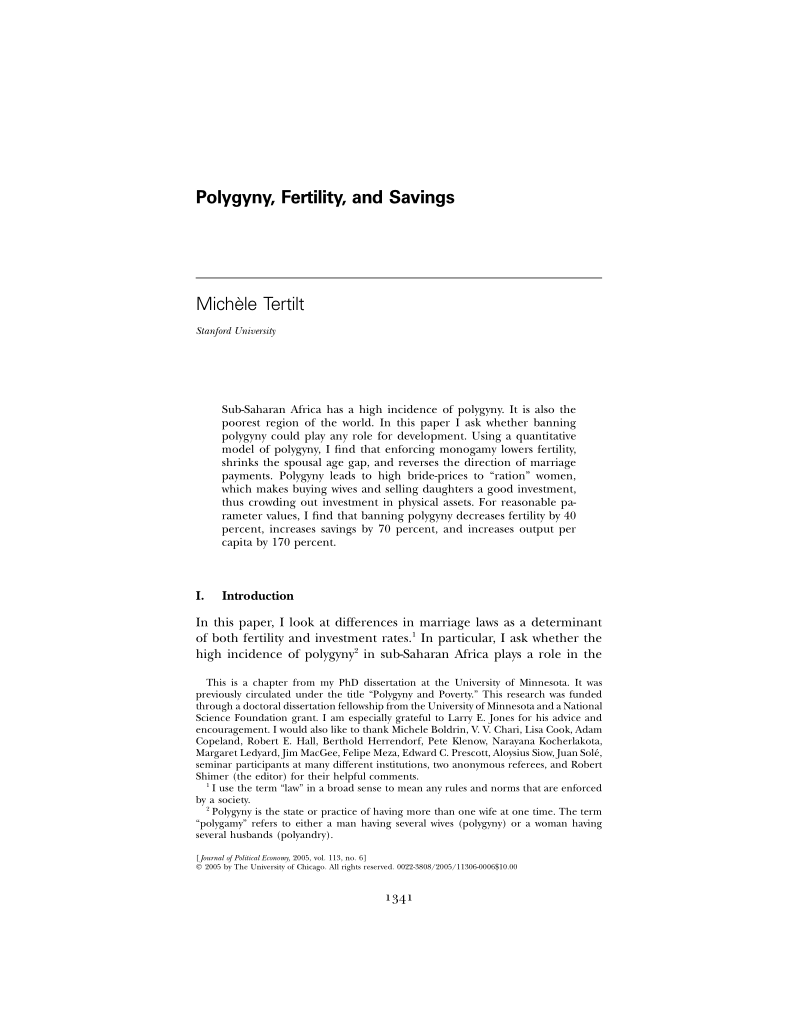Michѐle Tertilt analyzes variations in polygyny across Africa and concludes that polygyny is associated with higher population growth.
- Type
- Academic / Technical Report
- Source
- Michѐle Tertilt Non-LDS
- Hearsay
- Secondary
- Reference
Michѐle Tertilt, "Polygyny, fertility, and savings." Journal of Political Economy 113, no. 6 (2005): 1365-1366
- Scribe/Publisher
- Journal of Political Economy
- People
- Michѐle Tertilt
- Audience
- Internet Public
- Transcription
VI. Conclusion
In this paper I analyze the macroeconomic consequences of allowing men to marry multiple wives. I find that banning polygyny has large effects along several dimensions. The increased demand for wives created by allowing polygyny always means that the value of a bride is strictly positive, whereas it may be negative when men are restricted to marrying one wife. The assumption that fathers may buy and sell daughters, but not sons, means that a positive bride-price makes children a much better investment than when the price is negative. Therefore, polygyny leads to high fertility and partially crowds out investment in physical assets. Low investment and high population growth both contribute to a lower capital-output ratio and thereby to lower output per capita. I show that for reasonable parameter values, enforcing monogamy reduces fertility by 40 percent, increases savings by 70 percent, and raises output per person by 170 percent. These figures suggest that, although the practice of polygyny is certainly not the sole cause of poverty, it might be an important contributing factor to the continuing underdevelopment of sub-Saharan Africa.
It might be difficult to enforce a marriage law that prescribes monogamy. Several countries have introduced such laws without much effect on actual marriage behavior. An alternative policy often proposed by development institutions such as the World Bank is to give more rights to women. Allowing women to make their own marriage decisions would significantly reduce the return on wives for men. Thus such a policy should also increase the incentive to invest in physical assets. Results not reported here show that this policy increases both the savings rate and GDP per capita by roughly 60 percent; the effects on fertility and the number of wives are small, which shows that a smaller increase in living standards might be achievable without a change in the marriage law.
Another interesting extension would be to see how the analysis extends to family altruism in the sense of Barro and Becker (1989). Altruistic parents would take the trade-off between quantity and quality of children into account. Altruism could potentially induce parents to have fewer children and save more, leading to a higher capital stock and higher wages for the children. It is unclear how important this effect would be quantitatively. The effect of altruism on savings would be present in both family arrangements, so that the quantitative differences between the two environments might not change much.
- Citations in Mormonr Qnas
The B. H. Roberts Foundation is not owned by, operated by, or affiliated with the Church of Jesus Christ of Latter-day Saints.

